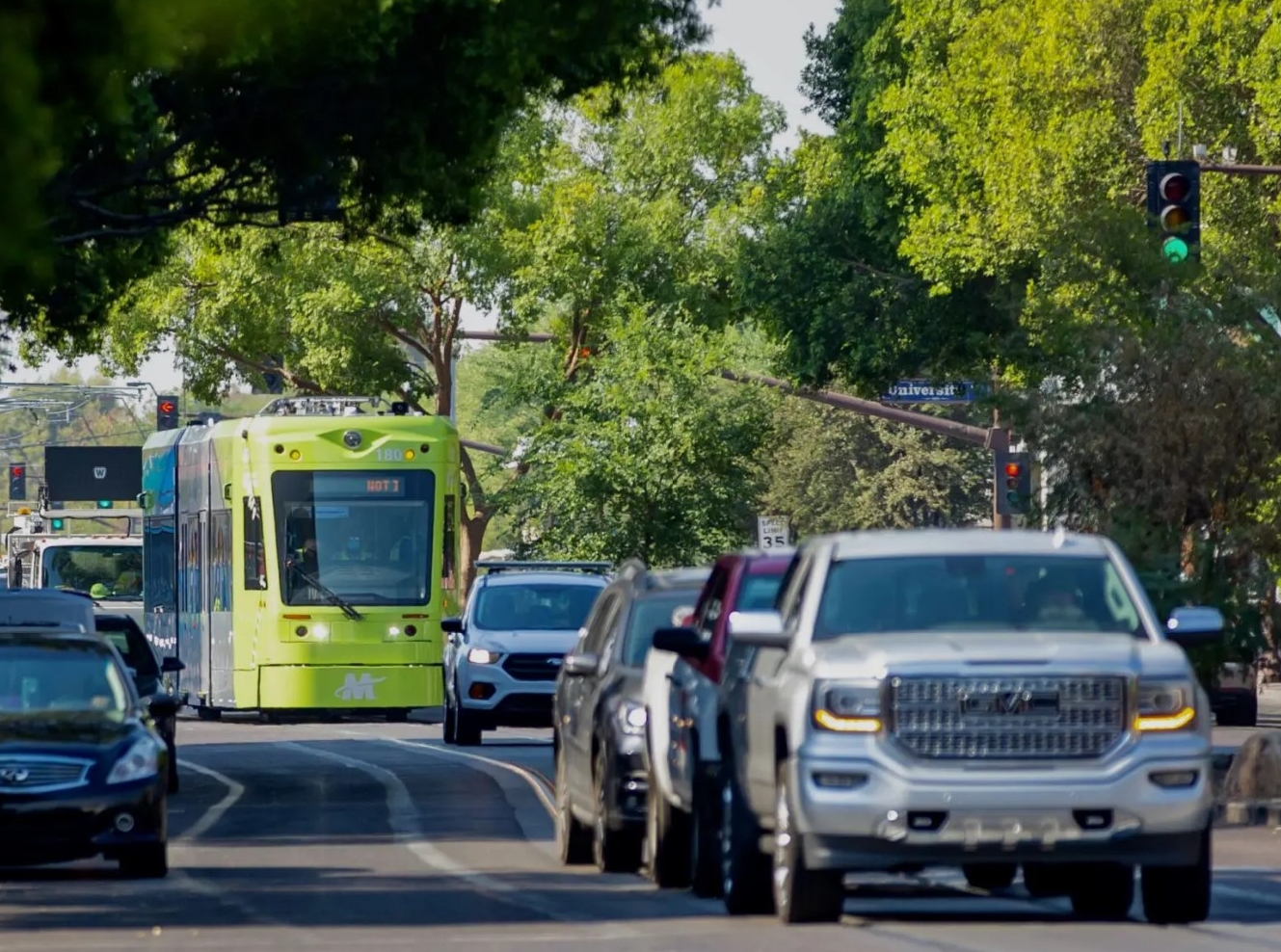
The Jolly Green Trolley is rolling.
After nearly a decade of debate over its cost and route, 3-plus years of disruption to businesses and traffic during installation of its rails followed by months of testing along the line, the Tempe Streetcar madeits debut on May 20, and riders get a free ride on the green-and-silver beast during its opening year.
The long-awaited, nearly $200 million, 3-mile-long system is intended to create a more-connected downtown.
“We are really excited about the streetcar coming into play in the city of Tempe, particularly to add to our regional infrastructure along with light rail and bus rapid transit,” said Tempe Mayor Corey Woods. “We are looking forward to doing everything we can to make sure our residents and visitors can get anywhere around the Valley without a car, if they choose to.”
Tempe’s is the first modern streetcar line in the Valley, connecting riders to the city’s historic neighborhoods, small businesses, and arts and cultural destinations. Tempe Streetcar will serve the Arizona State University campus, ASU Gammage, Sun Devil Stadium and Tempe Beach Park, among other stops.
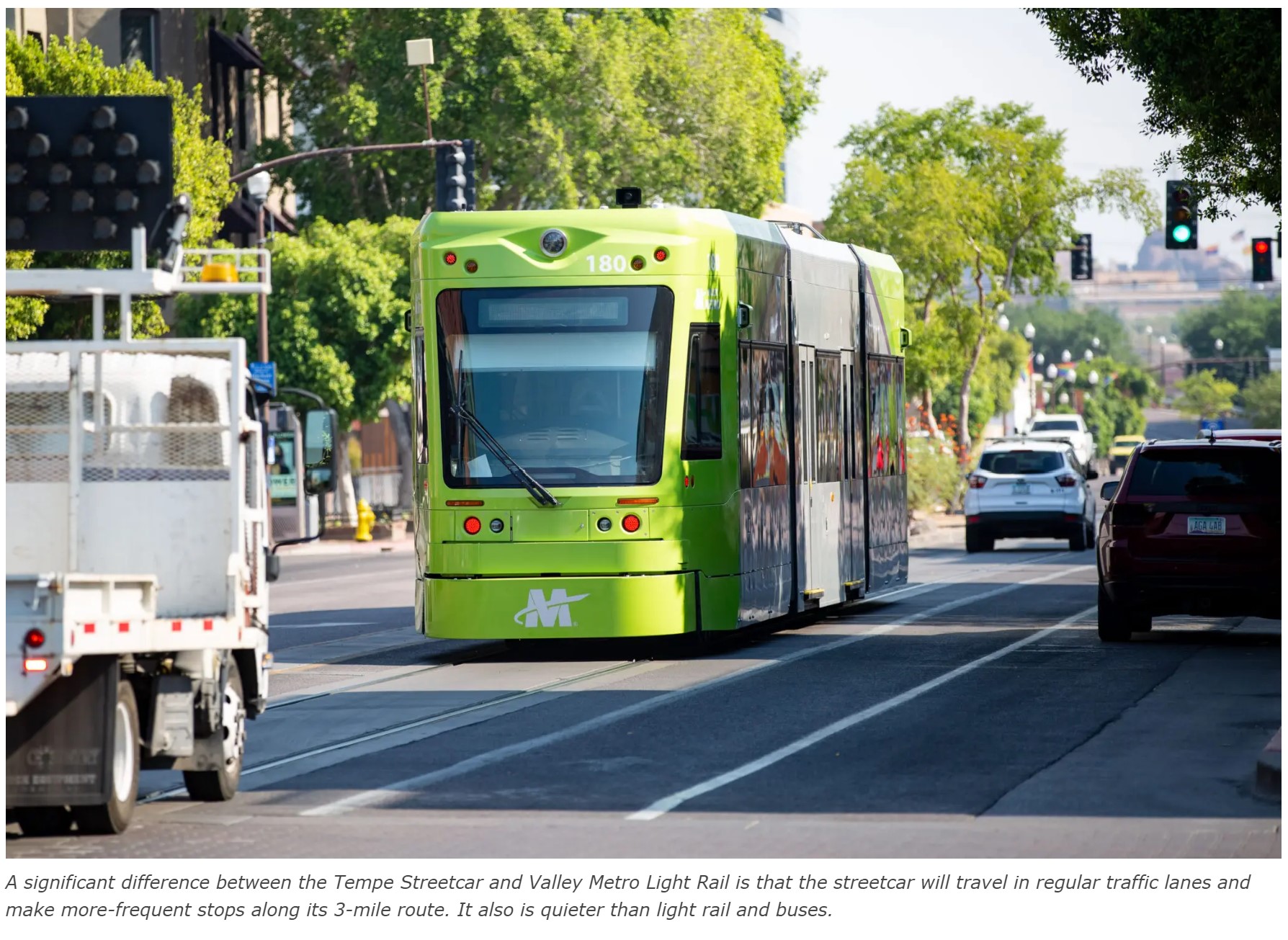 The route starts on Rio Salado Parkway at the massive Marina Heights development that houses State Farm, and then heads west to Ash Avenue, south on Ash to University Drive, east to Mill Avenue, continuing south on Mill to Apache Blvd., then turning east to the Dorsey/Apache Light Rail Station. On its return trip to Marina Heights, the route goes north on Mill Avenue to Rio Salado Parkway.
The route starts on Rio Salado Parkway at the massive Marina Heights development that houses State Farm, and then heads west to Ash Avenue, south on Ash to University Drive, east to Mill Avenue, continuing south on Mill to Apache Blvd., then turning east to the Dorsey/Apache Light Rail Station. On its return trip to Marina Heights, the route goes north on Mill Avenue to Rio Salado Parkway.
There are 14 sheltered stops — more like bus stops than those of light rail in that they are more frequent than light-rail stops — with unique public art and landscaping that are Americans with Disabilities Act-compliant and accessible by bicycle. There are two connections along the line to light rail.
It won’t be a free ride after the first year.
“We will have a fare system in place but we’re still kind of determining what that is going to be,” said Madeline Phipps of Valley Metro.
With its frequent stops, the streetcar is more like a bus than like light rail, the fundamental difference being that the streetcar shares lanes with street traffic rather than having a dedicated lane.
That created challenges designing a system to operate on downtown Tempe streets shared with congested vehicular and pedestrian traffic while powered in stretches by hybrid technology.
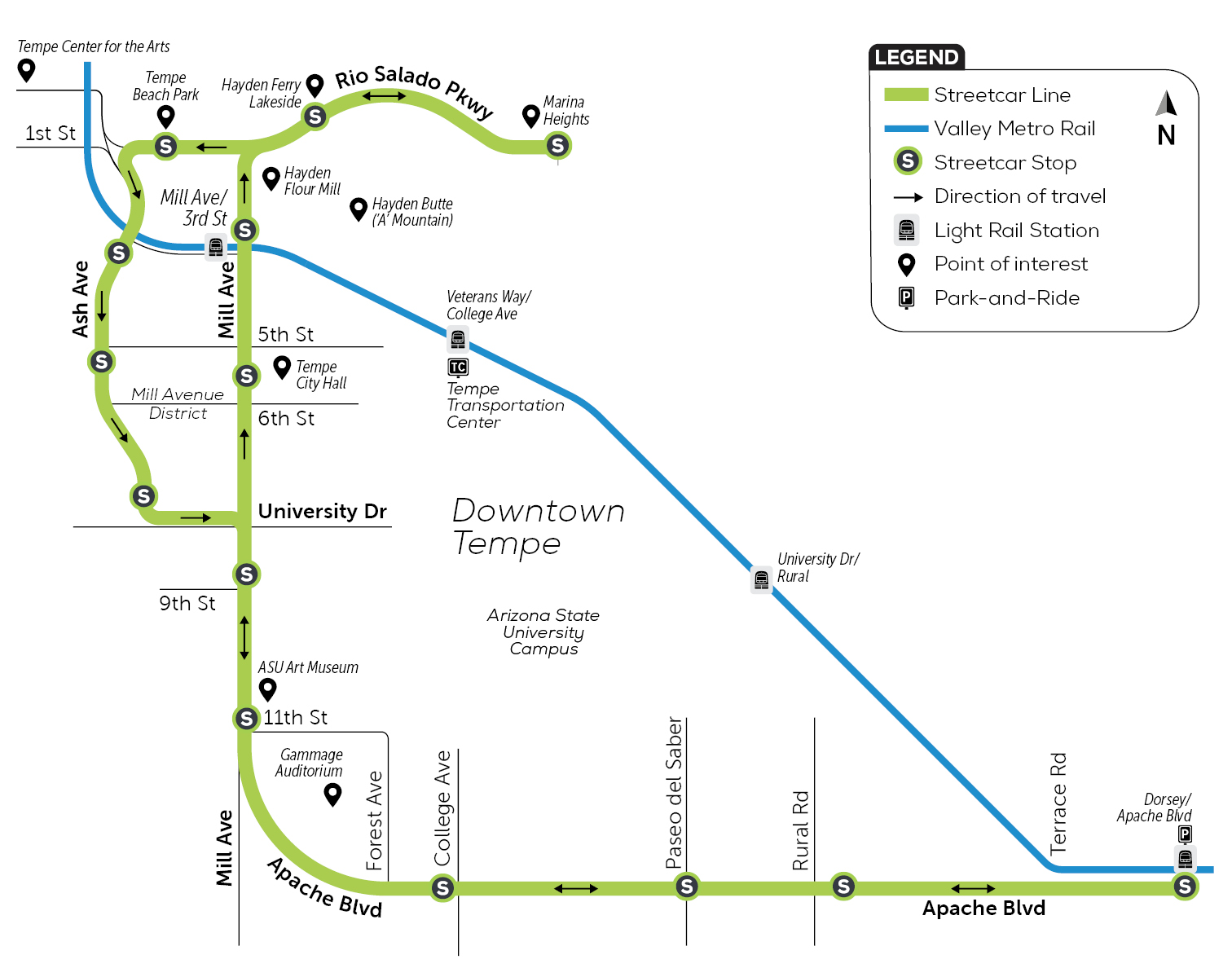
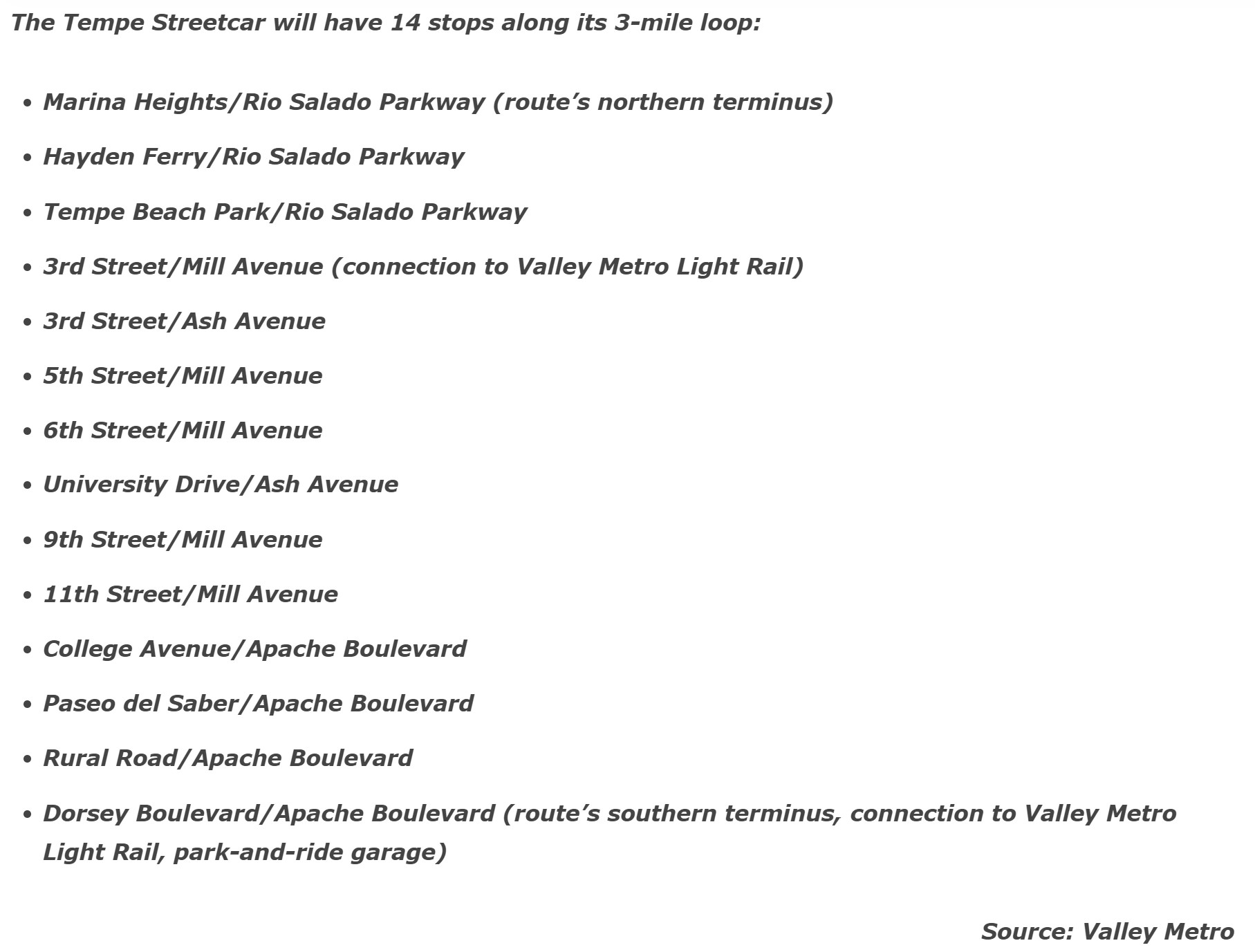 Unlike light rail, the streetcar is powered by overhead wires along most of the route but switches to reserve power stored in its lithium-ion battery along some stretches. This feature was particularly attractive to Tempe, which did not want to uproot trees and destroy landscaping along Mill Avenue in order to install overhead wires.
Unlike light rail, the streetcar is powered by overhead wires along most of the route but switches to reserve power stored in its lithium-ion battery along some stretches. This feature was particularly attractive to Tempe, which did not want to uproot trees and destroy landscaping along Mill Avenue in order to install overhead wires.
“Obviously, it’s a new mode of transit for Valley residents, and the fact that it shares traffic lanes with cars is a new thing,” Phipps said. “It’s safe to drive in the same lane, for the most part, but drivers should follow the signage and keep back a safe distance. Treat it like any other vehicle. The streetcar will obey the same traffic signals as all traffic. The operator will stop at red lights. It will do the same things that cars do.”
The streetcar operates as a single car rather than in a train of two or three connected cars, as with light rail. The 72-foot long streetcar’s two hinges allow for tight turns and give the appearance of being three cars.
Valley Metro advises those who ride bikes and scooters to not ride between the rails because it is difficult to maneuver in the tight space and their tires could get stuck in the track’s grooves.
It also emphasizes that pedestrians cross streetcar tracks only at designated crosswalks. The streetcars are quiet – much quieter than the light rail – so pedestrians must be aware of surroundings and the signals.
Existing street parking did not need to be removed except for the equivalent of three parking spaces at each stop and to clear adequate turning radius in some locations.
Valley Metro purchased six vehicles from Pennsylvania-based Brookville, the only maker of streetcars designed and manufactured exclusively in the U.S., on a $33 million contract awarded in 2017.
Four vehicles will be on the system at a time running at 15- to 20-minute intervals. Each has 40 seats. With standing room, a streetcar can transport roughly 120 people along the short-hop line.
So who will ride it?
“We anticipate all kinds of people using this,” Phipps said. “Students at ASU, employees at Marina Heights, people coming to Tempe from other parts of the Valley for arts or cultural events, people traveling from Sky Harbor can use light rail and then connect to the streetcar in Tempe.
“Certainly, it is designed for those shorter trips within the city because it has more frequent stops. It’s more of a connector between our different transit systems in the Valley.”
Anticipated weekday ridership is 2,250 to 2,750, according to Phipps.
HOW TEMPE STREETCAR WAS FUNDED
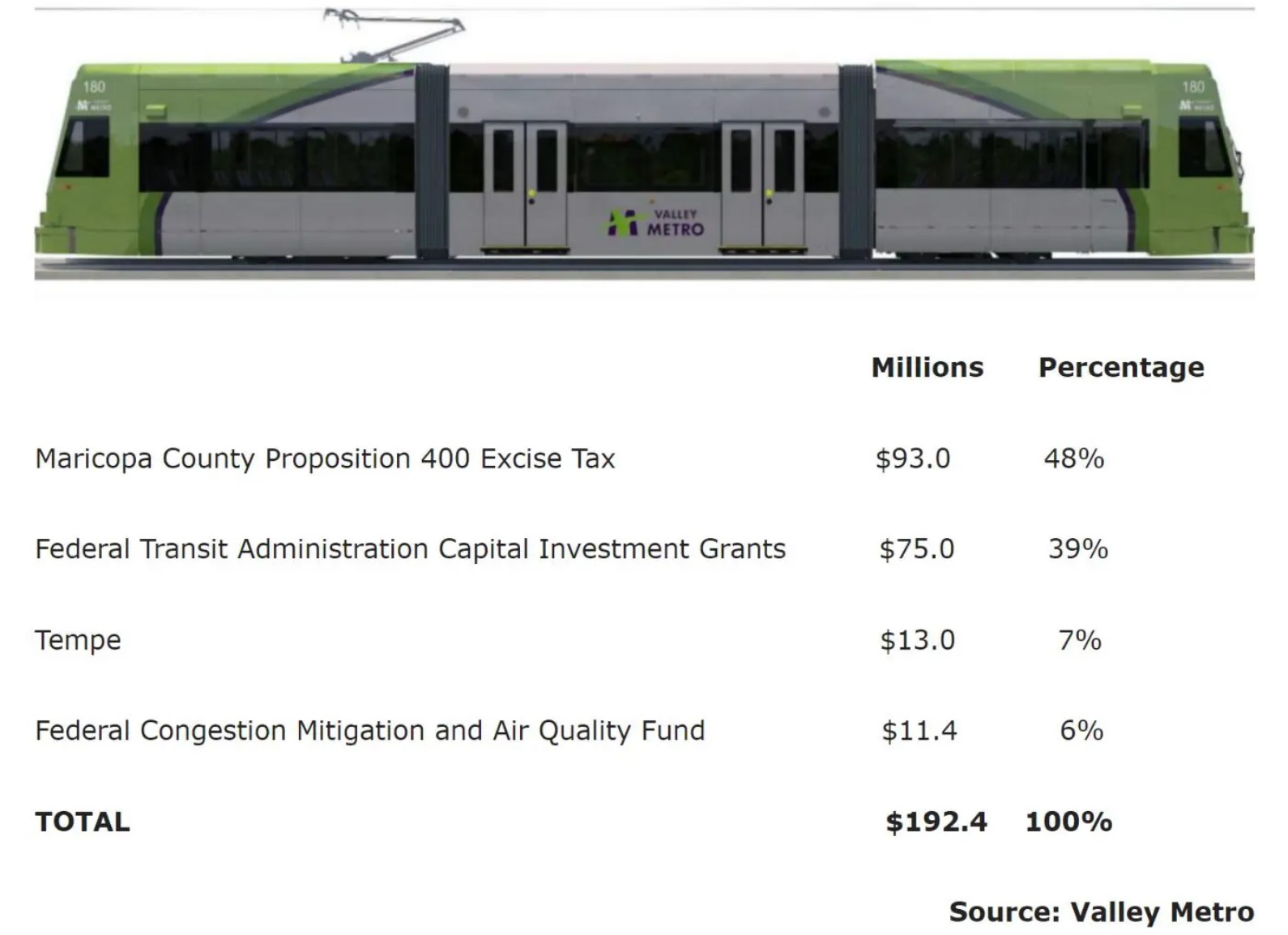 The cost, paid with a mix of federal, regional and local funds, has been controversial from the start. Tempe also will pay the estimated annual operating and maintenance cost of $3.1 million. Some critics suggested that it would be less expensive to add buses that run on compressed natural gas.
The cost, paid with a mix of federal, regional and local funds, has been controversial from the start. Tempe also will pay the estimated annual operating and maintenance cost of $3.1 million. Some critics suggested that it would be less expensive to add buses that run on compressed natural gas.
“Roadways downtown are pretty much near capacity,” Phipps said. “The streetcar can transport more people more efficiently. Knowing we have traffic as an issue, efficiency is a consideration. Adding in more buses wouldn’t necessarily solve the problem. We need to move more people more quickly. Thinking toward the future, as Tempe continues to grow and there is still-more travel demand, it’s really about serving the community there and anticipating what the future’s going to bring.
“This system gets cars off the street, at least that’s certainly what we anticipate.”
Also, modern streetcars are quieter than buses and light-rail trains.
Tempe, which has the most densely populated downtown among Valley suburbs, with its high-rise residential structures and the Arizona State University campus just off Mill Avenue, has been proactive in creating multimodal transportation, hoping to get as many automobiles as possible off its crowded downtown streets.
“We didn’t build any new park-and-rides for this project, but the existing one at Dorsey and Apache also will serve the streetcar,” Phipps said.
Valley Metro, in coordination with Tempe, recommended the current route, a slight tweak from an initially proposed 2.6-mile loop, to better fit federal funding criteria. In April, 2013, the Federal Transit Administration approved the project, the first step toward getting it funded.
With FTA funds along with money from several other sources secured, construction began in 2017 on the joint project between Valley Metro and Tempe Public Works Department.
Stantec Consulting Services, which designed other streetcar projects in the U.S., also designed this project.
Before the first passenger steps aboard, discussions are taking place about expansion of the streetcar line to possibly include stops at Tempe Marketplace, and into Mesa at Sloan Park, Riverview Park, Mesa Asian District and Mesa Community College.
Planners envision the streetcar supporting the Tempe-area transit network with an ability to attract new riders, increase mobility, strengthen existing neighborhoods and create sustainable development. It could positively impact housing values near the route as it not only connects to downtown attractions but also connects to Valley Metro Light Rail to downtown Phoenix and downtown Mesa.
Streetcar rails are the same gauge as those of light rail so streetcar vehicles can travel on the light-rail track. In fact, every night, the streetcars will switch over onto the light-rail track and travel to the maintenance center at 30th Street and Washington to be serviced.
More information: valleymetro.org/project/tempe-streetcar.


